分析音乐射击游戏《Gun Godz》的表现优缺点
作者:Rami Ismail & Jan Willem Nijman
当好友Brandon Boyer邀请我们在其Venus Patrol Kickstarter制作一款小型游戏时,我们知道自己无法说不。在我们看来,新版Offworld(游戏邦注:这是围绕电子游戏文化关联性的网站)的构思是这一平台的重要特性。
出乎意料的是,我们最终制作的是基于黑帮饶舌乐的第一人称射击游戏。同样令我们没有想到的是,自己最终会在《Gun Godz》投入5个月的业余时间,这款游戏至少能够获得1500名用户。项目不是出于赚钱目的,而是出于宣传文化常识,出于支持Venus Patrol平台。
《Gun Godz》的设计受到两点启发。第一是设计师Jan Willem Nijman对于侵略文化的着迷。我们亲眼目睹近来Vlambeer社区暴力现象的日益增多。
商业活动负责人及程序员Rami Ismail亲眼目睹一场商场枪战,去年还遭遇持刀抢劫情况,我们发现身边的世界似乎变得有些粗糙。这是我们所无法忽视或置身事外的现象。暴力——主要是欺骗行为,是我们不希望看到的现象。
在Jan Willem看来,暴力内容变成一种魔力,这促使他开始聆听50 Cent及其他更早、更优秀的黑帮饶舌乐。我们都觉得这是个非常令人不安的发展趋势。无论如何,我们决定将曾经的流行文化广泛植入游戏中,以此表达自己在此的立场。
那么游戏采用什么形式?这是款老派的第一人称射击游戏,故事发生在Venus的唯一建筑中——在此世界中,饶舌歌手就是神祗。我们在出乎意料的情况下制作出一款暴徒游戏。我们无需调整游戏的暴力内容,就像现代射击游戏经常融入若干矫揉造作的荒谬情境,如剥夺玩家控制权,在游戏中发射核弹,或杀害小孩。
这是基于黑帮饶舌乐的典型第一人称射击游戏。若我们想要着眼于此,就需要严肃对待主题:没有玩笑,全部围绕暴徒内容。
表现突出之处
1. 交互设计和即时建模
在Vlambeer,我们认为游戏若没被用户体验就不算是游戏。没被玩家体验,游戏就只是系列代码、资产及一个图标。所以当我们脑中出现构思时,我们就对其进行建模。我们只需几小时就能够制作出一个粗糙模型,然后我们会查看核心设计构思是否具有可行性。
在这一项目,我们想出的第一个构思是,组织严密的绑匪风格射击游戏。玩家可以从3个“Gun Godz”中进行选择——机关枪神、猎枪神或者火箭炮神。在Venus的唯一建筑中,他们会被警察追逐,必须争取抢先进入下个平台,同时消灭尽可能多的敌人。
我们原本计划融入各式各样的道具,让玩家能够塑造自己的体验风格。我们设有传统道具——发射速度、重载时间及破坏性,同时还植入许多荒诞可笑的道具。有些道具会让导弹遵循你的轨迹,或让子弹弹出墙面,亦或是环绕在屏幕周围。寻找更多构思是个有趣过程。
核心构思具有可行性,所以我们连续3周每周腾出2天时间制作这款游戏。但原型很快就陷入困境。若在游戏中植入丰富内容,游戏有可能变得趣味横生,但我们无法确定这么做后,设计构思是否依然具有可行性。于是我们放弃原有内容,从头开始。
尝试众多创意方案及新玩法后,我们开始着手制作一款杰出的第一人称射击游戏,游戏丝毫不亚于之前的经典之作。机关枪神变成敌手。故事很快从跳脱警察的追捕转变成一个普罗米修斯式的故事:玩家将枪械带给人类,惹怒Gun Godz,因此受到他们的追捕。最终,这变成邪恶饶舌品牌所有者阶下囚的故事。显然,所有情节逐步变得明朗。
2. 简单的游戏
我们尝试保持游戏的简单性。原因有两个——我们资源有限,这是个免费项目,但同时我们也主张简约的游戏设计。规则越少,各具体规则蕴含的职责就越大,我们就越容易做出细微的渐进完善。
简单性并非和深度水火不容,简单规则的稳固结合能够带来富有深度的玩法。我们将这一理念落实到我们的多数游戏作品中,最典型的例子就是《超级包装箱》。最重要的是,这款简单游戏只围绕优质的射击内容。
3. 玩法
虽然《Gun Godz》看起来像是《Wolfenstein 3D》的衍生品,但体验起来截然不同。我们借鉴传统射击游戏的简单性,尝试从现代游戏设计视角着手设计工作。我们决定让游戏建立在如下3个元素之上:枪械、敌人和关卡。我们将通过这些内容叙述故事。我们的游戏就是故事内容。
《雷神之锤》和《执法悍将》之类的游戏堪称经典之作。《雷神之锤》从一开始就积极融入紧张玩法。将玩家置于特定关卡;给予他们武器及射击内容。这一设计简单而考究——是相当巧妙的玩法。
我们欣赏他们的做法,于是决定将自己局限在关卡设计中。我们设有墙面、门及障碍。障碍阻碍玩家移动(游戏邦注:但允许子弹穿过)。
这3个关卡元素正好就是我们需要的内容。《Gun Godz》的关卡叙述故事,聚集弹药和健康值,包含若干秘密及稀有爆炸性炮管——最主要的是,他们会塑造玩家和敌人的互动方式。这就是《Gun Godz》的关卡设计:塑造战斗。
敌人的设计主要围绕将战斗变得刺激、更出乎意料、更迅速。他们都有具体角色,会在任何组合中默契配合。多数敌人都脆弱而危险——我们积极追随他们的步伐。
4. 武器
我们投入多个礼拜完善枪械的设计。Jan Willem花费数天调节屏幕震动设计,只是为了让急射小机枪感觉更合理。我们融入多功能手枪,短程致命猎枪,急速空间扫射小机枪,还有致命火箭炮。快速的赛跑者会非常喜欢他们的右鼠标按键,习惯通过刀子快速“刺中”敌人。
要在《Gun Godz》表现突出需要持续变换武器。各武器适用于不同情境,射击武器带给人美妙的感觉。《Gun Godz》主要围绕运用各种武器;运用各种武器就是《Gun Godz》。这就是故事的主要内容,这就是游戏的主要内容。
5. 风格
《Gun Godz》包含众多掠夺品。Vlambeer能够持续存在,要归功于团队两个成员的显著差异——Rami是AAA玩家,是编码员,倾向以商业思维考虑问题,而Jan Willem更多是美工游戏设计师。这一动态差异造就了我们的最终作品。
在《Gun Godz》中,我们积极将这一“做自己最擅长的事”的态度在游戏风格中充分体现出来。我们聚集各路杰出人士:犯罪主题的美工,荷兰图素美工及射击内容厌恶者Paul“Pietepiet”Veer,芬兰音乐奇才Jukio“KOZILEK”Kallio,最后是美国饶舌歌手Adam“Doseone”Drucker。
我们没有告诉他们该怎么做,这会白白浪费人才的多元化优点,相反我们只是大致告诉他们我们即将制作什么样的内容及其中存在的技术限制。在我们看来,聘请自由职业者制作游戏,就要给予他们完全的创造性自由。他们比我们更擅长于具体的专攻领域——否则我们就不需要聘请他们。
Paul对于射击主题的厌恶情绪促使他得以创造出新鲜的风格—–有点像《Wolfenstein 3D》,但内容更复杂,更有生气。Jukio以并不存在的Venusian语言制作帮派说唱乐,这非常适合整个气氛。Adam最终编出一段美妙的主题曲,完成所有音效制作和配音工作。
表现不尽人意之处
1. 首个游戏情境
《Gun Godz》的多数关卡都是按时间顺序制作的。最先进行的是首个情境的首个关卡,我们最后着手的关卡是最后一个情境的秘密关卡。在制作过程中,我们在关卡制作方面越来越得心应手,能够充分利用手头的所有工具;最后的情境包含若干紧凑战斗和有趣敌人。
我们决定采用传统方式,在“各关卡中引入新武器或敌人”——这令我们得以利用着手新关卡时手头具备的工具。基本敌人角色一开始就出现在游戏中,所以待到我们完成首批关卡后,我们就知道要将他们放置在精彩战斗的什么位置。
虽然在敌人和武器方面,初期关卡都存在一定限制性,但我们还是犯下几个错误。游戏的首个情境画面是监狱,玩家需要从监禁中跳脱。玩家通过下水道寻找出路,穿越旅馆的地下室,最终达到旅馆顶部,同嘻哈乐决策者及Gun God进行最后对峙。唯一问题是,在首个情境中,我们基于障碍元素生成牢房。这令前3个关卡包含众多走廊。
事后回想,我们应该让玩家在基本模式之上的情境中适应游戏,而不是在看起来似乎很容易迷路的环境中。小屋减缓首个游戏空间的移动步伐,让玩家做好在随后游戏中适应不同节奏的准备。
有人也许觉得以慢节奏开始游戏不是坏事,但我们的游戏属于快速运转风格。游戏在玩家步入第二个情境(游戏邦注:即下水道)后就开始加速—–虽然我们将游戏情境设计成3个层次,让新情境的首个关卡易于之前情境的最后一个关卡。
这促使下水道情境的第二个关卡难度出现急剧提升——玩家并非进入充满火药味的房间中,这其实是最佳策略,玩家会仔细查看各角落,看看小屋是否空着。
2. Rat King
Rat King Baby是《Gun Godz》的首个boss。这是敌人精灵首次超过16 X 16像素。我们想要给游戏的前半部分设计个完美结局,确保杀死Rat King的玩家继续玩完整款游戏。
Rat King将成束的火球射向你,通过底下的火箭发射器生成两个触须,在下水道走廊中追捕你。Rat King Baby时不时会潜入脏水中,当它再次出现时,会以庞大的污水激流追逐你。
我们在Rat King存在的问题是,它是唯一处于刀枪不入状态的敌人。玩家应该射击和摧毁他们的触须,之后Rat King Baby就会开始哭嚎,让玩家得以对其展开攻击。经历短暂脆弱状态后,Rat King就会潜入水中,当它再次出现时会多出两个新触须。这一模式持续重复,直到玩家或Rat King死去。
呈现这一内容颇为棘手。我们试图在其腹部设置两个大眼睛,这迎合我们美工Paul追求的变种人/魔鬼总动员风格。当他处于脆弱状态时,眼睛就会睁开——眼睛变成一个典型弱点。
结果这丝毫不起作用。据测试结果显示,玩家首次遇到Rat King时,并不会仔细进行查看。他们会陷入恐慌状态。我们通过降低它的破坏性及健康值避免出现这种状况,让Adam制作清晰的破坏音效,通过消除音效暗示Rat King处在脆弱状态。
虽然这算不上完美,但就目前来看,当玩家首次接触Rat King时,他们就会发现它处于刀枪不入状态——但他们也许依然会朝角落靠近,进行数次试验,将自己的弹药浪费在刀枪不入的敌人身上,然后才理清整个情况。
这对传统射击游戏来说并非什么大问题,但用户预期已发生转变。如今玩家通常期望看到庞大的突出弱点及解释游戏模式的情境弹出窗口。
我们非常幸运,Venus Patrol用户都非常欣赏我们设计的游戏类型。他们不仅投资我们的游戏,还支持Venus Patrol的各种构思。他们愿意体验我们的游戏。他们的注意持续时间甚至和10年前的玩家保持一致。我们欣赏Venus Patrol支持者的这一特点。
3. 覆盖范围
《Gun Godz》是旨在免费支持Venus Patrol的游戏作品,所以我们融入组织严密的流氓风格主题,预期作品能够在10月完成。当时Vlambeer已成立,我们突然意识到自己制作的是,完全的传统第一人称射击游戏。
进行这一转换非常艰难。我们需要说服团队成员及周边人士无需就玩法做出更新——我打算基于这一玩法创造出杰出内容。这里包含众多的强迫性创新。在这种情况下,后退一步,单纯制作优质的射击游戏会让人变得豁然开朗。
当一切尘埃落定,我们体验整款游戏,就内容进行完善,收集隐藏在游戏中的52个三角形。Jan Willem花费3小时完成这一操作。Rami还有最后几个没找到。
4. 同时运行太多项目
《Gun Godz》在克隆质疑风波后诞生,我们的游戏《Radical Fishing》被某家旧金山公司抄袭,他们将自己的克隆作品投放至App Store。整个事件让我们变得有些消极怠工,暂时中断我们的iOS版《Radical Fishing》——《Ridiculous Fishing》。遗憾的是,这一消极情绪也弥漫至我们的其他项目,延误iOS版《超级包装箱》、《Serious Sam: The Random Encounter》和《Gun Godz》的发行进度。
当事情逐渐恢复时,我们的积极性又遭受打击,我们要同时应对4个大型项目。这实在太多了。
5. 开始听Tupac的音乐
在制作《Gun Godz》前,我们鲜少采用“yo”这个词语,不会在接电话时说Venusian语言的“wakkala”,通常不会在短信中回复“aight”。但这些词汇今后都将出现在我们的生活中——或者至少会延续到今年底。
我们想要留下小小文化印记(游戏邦注:通过《 Gun Godz》,他们实现这一目标)。出乎意料的是,这是我们自己的文化。
总结
Jan Willem在开发游戏的过程中有个梦想,希望Vlambeer能够受邀参加50 Cent的年轻英才烤肉会。他对此满怀憧憬。
制作《Gun Godz》是个突然的决定。开发过程非常顺利,但游戏最终的规模超出我们的预期。针对1500名用户制作此大型游戏需耗费众多精力,而且无法从中获得标准的“到处倍受好评”即时回馈。和以往一样,开发过程令我们筋疲力竭。
今天我们花了5分钟观看《Gun Godz》在YouTube的第一个视频内容。简单性促使内容变得富有价值。
《Gun Godz》是我们的杰出代表作品之一。我们非常喜欢这款游戏。我们严肃看待游戏涉及的内容。我们相信游戏依然是《50 Cent: Bulletproof》以来最优秀的嘻哈音乐型射击游戏。(本文为游戏邦/gamerboom.com编译,拒绝任何不保留版权的转载,如需转载请联系:游戏邦)
Postmortem: Vlambeer’s Gun Godz
by Rami Ismail & Jan Willem Nijman
[Created as a Kickstarter bonus for indie website Venus Patrol supporters, Gun Godz marks the first entry of Super Crate Box developer Vlambeer into the first person shooter genre -- and with one inspired by gangster rap at that. In this postmortem, Rami Ismail & Jan Willem Nijman explain how the project got its genesis and what went right and wrong as it was developed.]
When our good friend Brandon Boyer asked us to make a small game for his Venus Patrol Kickstarter, we knew we couldn’t say no. The idea of a new Offworld — a website about the cultural relevance of video games — is something we consider of extreme value to the medium.
What we didn’t know is that we’d end up making a gangster rap-inspired first person shooter. Neither did we expect that we’d end up spending five months of part-time work on Gun Godz — a game that will be played by at best 1500 people and a lot of pirates. Not for money, but for cultural literacy. For Venus Patrol.
Two things brought us to the design of Gun Godz. The first was a fascination with aggressive culture that our designer, Jan Willem Nijman, had. The two of us over here at Vlambeer have seen an increase of violence in our neighborhoods lately.
The business guy and programmer, Rami Ismail, was confronted with a mall shooting and was robbed at knifepoint just last year, and we realized that the world around us seems to have roughened up a bit. It’s not something we can easily ignore or keep out of our heads. Violence — mainly fake aggression — is something we weren’t used to seeing.
For Jan Willem, that violence turned into a fascination, which in turn led to him listening to a lot of 50 Cent and better, older gangster rap. We both agreed that that was a quite disturbing development. Either way, we decided to take what was once part of popular culture and throw it on a big pile of influences to make a game that we’d use to express our position in all of this.
So what form did that game take? An old-school first person shooter that takes place in the only building on Venus — in a world in which rappers really are gods. We were suddenly making a gangster game. We didn’t need to justify the violence in our game, like modern shooters try to with some pretentious nonsense scene where they take away player control and launch a nuke in the background, or kill a kid.
A true gangster rap-inspired first person shooter in the vein of the classics. If we wanted to pull this one, we would need to be dead serious about our theme: No jokes, all gangster.
What Went Right
1. Iterative Design and Instant Prototyping
At Vlambeer, we believe a game isn’t a game unless it’s being played. Without that, a game is a bunch of code and assets and an icon. So when we have an idea, we prototype it. We whip up a really, really crude prototype in a few hours at most and we check whether the core design ideas work.
For this project, the first thing we came up with was a top-down roguelike shooter. People would play through the game as one of three Gun Godz — machine gun god, shotgun god or bazooka god. They would be chased through the one building on Venus by the cops and have to race to the next floor while killing as many enemies as possible.
We had planned to have lots of diverse, stacking powerups that would allow players to forge their own playing style. We had traditional powerups — rate of fire, reload time, damage — but also more ridiculous ones. Some powerups would make your projectiles circle you, or make bullets bounce of the walls, or wrap around the screen. It was pretty fun coming up with more ideas.
The core idea worked, so we worked on it for two days every week for three weeks. At that point, the prototype quickly ran into trouble, though. The game could potentially be fun if we pumped it full of content, but we couldn’t know for sure that the design would work if we did that. We scrapped everything and started anew.
After a lot of creative projects and experimenting with new gameplay, we started working on making a really good first person shooter that could outdo the classics. The machine gun god turned into the antagonist. The story quickly solidified from escaping from the cops into a Prometheus story in which the player brought guns to mankind and was being chased by the wrath of the Gun Godz. It the end, it turned into the story of the prisoner of a malign rap label owner. Obviously, everything fell into place.
2. Having a Simple Game
We tried to keep the game simple. The reason is twofold — we had limited resources, as this was a free project, but we also believe in minimalist game design. The fewer rules your ruleset has, the more responsibility you can give every single one of those rules, and the easier it is to make small, incremental improvements.
Simplicity does not exclude depth, as a strong combination of simple rules can make for incredibly deep gameplay. We’ve applied this philosophy to most of our games, with the most obvious example being Super Crate Box. The thing is, this simple game could solely be about really good shooting.
3. Gameplay
While Gun Godz looks like a game from the Wolfenstein 3-D generation, it doesn’t play like one. We took the simplicity of old-school shooters and tried to approach such a design from the perspective of modern game design. We decided to base the game on just three things: guns, enemies, and levels. We would tell our story through these things. Our game is the story.
Games like Quake and Outlaws are some of the best we’ve ever played. Quake (and more recently Rage, to an extent) manages to get extremely intense gameplay down right from the start. Put the player in a level; give them a weapon and something to shoot. It’s simple and elegant — it’s beautiful gameplay.
We liked that approach, so we decided to limit ourselves in terms of level design. We have walls, door and bars. Bars obstruct player movement but allow bullets to pass through.
These three level elements turned out being all we needed. The levels in Gun Godz tell the story, host ammo and health pickups, have some secrets and the rare explosive barrel — mainly, they shape the way the player interacts with the enemies. That’s what the level design in Gun Godz does: shape battles.
Enemies are designed around making battles exciting, slightly unpredictable, and fast. They all have very specific roles and are designed to work well together in any combination. Most enemies are weak but dangerous — something we used to keep up the pace.
4. Weapons
We spent weeks making the guns perfect. Jan Willem spent days tweaking the screen-shake just to make the minigun feel right. We have an all-purpose but never-useless pistol, a short-range death-dealing shotgun, a rapid-fire, room-clearing minigun, and a deadly bazooka. Speed runners will love their right mouse button, used to “shank” enemies quickly with their knife.
Being good at Gun Godz involves switching weapons constantly. Every weapon is useful for a different situation and firing every weapon feels good. Gun Godz is about firing every weapon; hell, firing every weapon is Gun Godz. That’s what our fiction is about, that’s what our game is about.
5. Style
Gun Godz has more swag than you or we will ever have. Vlambeer has always existed due to a sort of dynamic of disagreement between the two of us — Rami being a bit of a triple-A gamer, coder and business-minded person, and Jan Willem more of an artistic game designer. That dynamic is what — in the end — leads to what we make.
With Gun Godz, we tried to magnify this “do what you do best” attitude in the style of the game. We brought together a diverse set of influences: our artist-in-crime, Dutch pixel artist and shooter-hater Paul “Pietepiet” Veer, Finnish “wrong but lovely electro” music wonder Jukio “KOZILEK” Kallio, and finally, American rapper Adam “Doseone” Drucker.
Instead of wasting this diversity by telling them what to do, we gave all of them a general idea of what we were going to create and the technical limitations. We really believe that if you get freelancers to work on a game, you should allow them to have total creative freedom. They’re better at what they do than we are — otherwise we wouldn’t have needed them.
Paul’s dislike for shooters allowed him to create a truly fresh style — it’s a bit Wolfenstein 3-D but way more intricate, vibrant and alive. Jukio started making gangster raps in a non-existant Venusian language, which turned out to fit the mood perfectly. Adam ended up rapping an amazing theme song and doing all the sound effects and voice acting.
What Went Wrong
1. The First World
Most of the levels in Gun Godz were made chronologically. Work started with the first level in the first area, and the last level we put our hands on was the secret level of the final area. While working, we got better at making levels, going all out with the tools we had; the final area has some of the most intense battles and interesting uses of enemies.
We decided to go with the old-school “introduce a new weapon or enemy in pretty much every level” — which also allowed us to work with tools we knew as we started a new level. The basic enemies were in the game from day one, so by the time we had finished the first levels, we knew how to place them for cool battles.
While the early levels all have limited possibilities when it comes to enemies and weapons, we made a few mistakes. The first area in the game is the jail environment, where players have just escaped from their imprisonment. Players fight their way through the sewers, past the basements of the hotel, and finally to the top of the hotel of the hip-hop executive and Gun God for a final confrontation. The only thing is that in the first world, we used the bar elements to make cells. This makes it seem like the first three levels have a lot of corridors.
In hindsight, we probably should have given players a chance to get used to the game in a super-basic environment, not in a place where it looks like you could get lost easily. The cells slow down movement in the first world a bit and make people expect a different pace from the rest of the game.
One might argue that it’s not bad to start the game slowly, but our game is about going fast. The game picks up speed once the player gets to second world, a sewer — even though we designed the worlds in packs of three and made the first level of a new world easier than the last level of the previous world.
This caused a notable difficulty spike in the second level of the sewer world — instead of running into rooms guns blazing, which is exactly the optimal strategy, people carefully peek around corners to see if the cell is empty.
2. The Rat King
The Rat King Baby is the first boss in Gun Godz. It’s the first time any enemy sprite is bigger than 16 by 16 pixels. We really wanted to put a nice spectacular finish to the first half of the game and make sure that people who kill the Rat King are invested in playing through until the end of the game.
The Rat King shoots beams of fireballs at you, and spawns two tentacles with rocket launchers that go underwater and chase you down sewer corridors. Every now and the Rat King Baby dives under the dirty water, sending huge shockwaves of sewage to chase you as he reemerges.
Our issue with the Rat King is that it is the only enemy that has an invulnerable state. Players are supposed to shoot and destroy the tentacles, after which the Rat King Baby starts crying, allowing the player to damage him. After a short while of vulnerability, the Rat King dives under water, comes back up and spawns two new tentacles. That pattern repeats until either the player or the Rat King dies.
Communicating this turned out to be tough. We tried giving him two big eyes in his belly, which fit the mutant/Total Recall style our artist, Paul, went for. These eyes open up when he is vulnerable — eyes being a classic weak spot.
That turned out to be rather ineffective. When the Rat King appears, playtesting revealed that people don’t take a good look at the Rat King when they first encounter it. They panic. We lowered its damage and health to counter that and got Adam to create clear sound effects for damage, and used a lack of sound effects to indicate the Rat King was in its invulnerable state.
While it isn’t perfect, in the current state people will figure out the invulnerability state as soon as they reach it for the first time — but they might still hug the corners and waste all their ammo on an invulnerable enemy for a few tries before figuring the whole thing out.
This might not sound like a big problem for an old-school shooter, but player expectations have shifted. Nowadays, players often expect big, glowy weak spots and contextual popups that explain the pattern.
We’re lucky that the people pledging to Venus Patrol are people that appreciate the type of game we were making. They had invested not just in our game, but in the ideas behind Venus Patrol. They are willing to deal with our game. They even have the attention span of gamers from 10 years ago. We love the Venus Patrol supporters for that.
Still, we shouldn’t have used this one-off invulnerability system.
3. Scope
Gun Godz was something we did for free to support Venus Patrol, so we had scoped the top-down roguelike to be done in October. Of course, at that point, Vlambeer happened and we suddenly found ourselves working on a full-scale old-school first person shooter.
That switch was a tough one. We needed to convince the team and the people around us that we didn’t need to do new things with the gameplay on this one — we were going to focus on doing good things with gameplay on this one. There’s tons of forced innovation. In such an environment, taking a step back and just making a really good shooter felt like a refreshing thing to do.
When we were done and the dust had settled, we tried to run through the game and perfect it, collecting every of the 52 triangles hidden in the game. It took Jan Willem three hours to do so. Rami is still trying to get his hands on the last few.
4. Running Too Many Projects at Once
Gun Godz happened right in the wake of a cloning controversy, in which our game Radical Fishing was cloned and rushed to the App Store by some San Francisco company. That entire episode demotivated us, putting our own iOS version of Radical Fishing, Ridiculous Fishing, on hold. Sadly, that demotivation echoed through in our other projects, delaying Super Crate Box iOS, Serious Sam: The Random Encounter and Gun Godz.
As things started to pick up again and our motivation started returning, we were suddenly working on four big projects at once. That turned out to be too much.
5. It Made Us Listen to Tupac
Before we made Gun Godz we rarely used the word “yo”, never picked up the phone with the Venusian “wakkala”, and we most certainly never replied to text messages with “aight”. This is something we’ll have to live with for the rest of our lives — or probably until the end of this year.
We strive to leave a little mark in culture — and with Gun Godz, we did that. Quite unexpectedly, it was our own.
Conclusion
Jan Willem had a dream during development where Vlambeer was invited to a barbeque for young, talented people at 50 Cent’s huge crib. He thoroughly enjoyed that dream.
Making Gun Godz was a blast — but a blast to the face. Development went smoothly, but we ended up making a way bigger game than we expected. Making a big game like this for only 1500 outspoken people takes a lot of effort and does not get you all the standard “nice reviews everywhere” instant reward. Development, as usual, killed us.
We spent the first five minutes today watching the first video of Gun Godz on YouTube. Someone did a speed run and completely crushed our par times. Simple things like that make it all worth it.
Gun Godz is probably one of the coolest games we have ever made. We love it. We are still dead serious about what this is all about. We believe it still stands strong as the best hip hop-inspired shooter since 50 Cent: Bulletproof.(Source:gamasutra)

























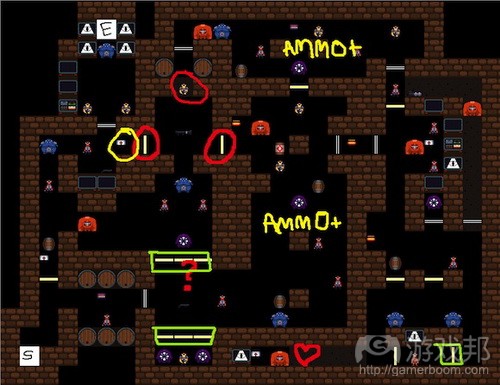
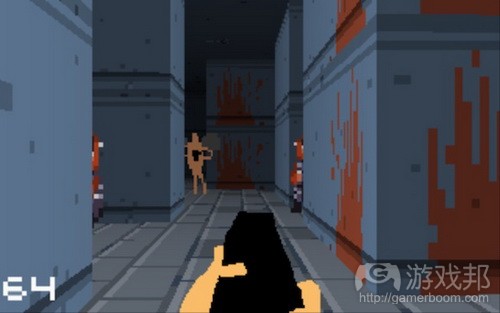
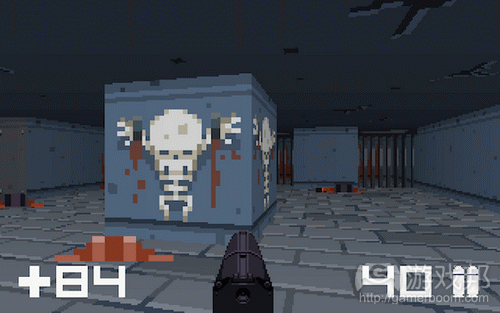
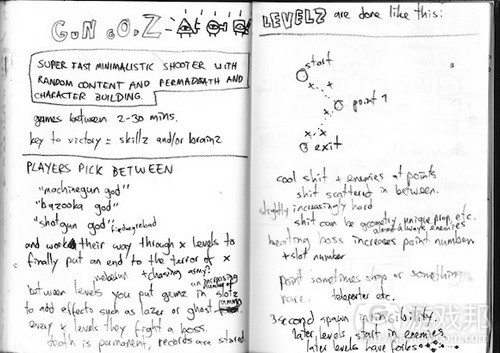

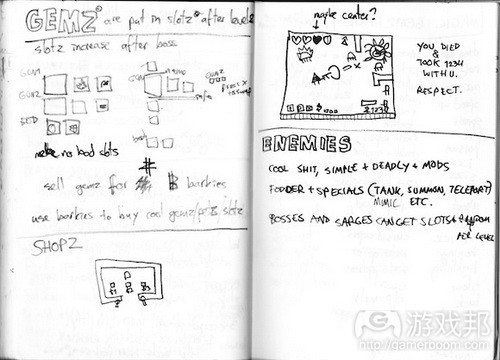














 闽公网安备35020302001549号
闽公网安备35020302001549号